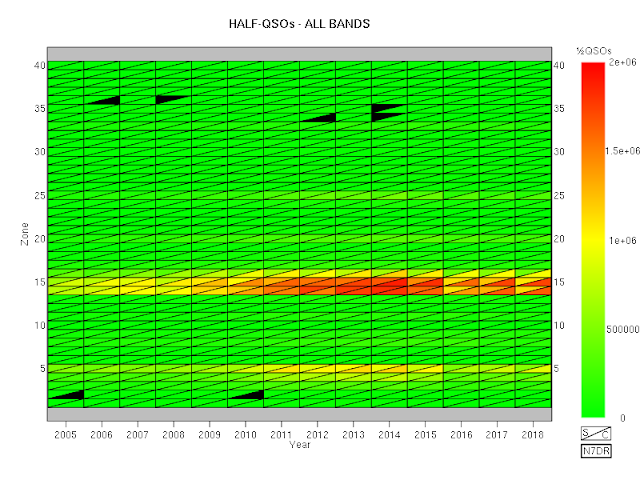Zone Pairs
We start by looking at the number of QSOs for pairs of zones from the CQ WW contests for 2018. The plots are created from the augmented file (cq-ww-2005--2018-augmented.xz; see here for details of the augmented format) derived from the public logs.
The procedure is simple. We consider only QSOs that meet the following criteria:
- marked as "two-way" QSOs (i.e., both parties submitted a log containing the QSO);
- no callsign or zone is bust by either party.
Separate figures are provided for each band, led by a figure integrating QSOs on all bands. The figures are constructed in such a way as to show the results for both the SSB and CW contests on a single figure. (Any zone pair with no QSOs that meet the above criteria appears in black on the figures.)
It is clear from these figures, as from those for earlier years, that CQ WW is principally a contest for intra-EU QSOs, and secondarily one for QSOs between EU and NA. This format is undoubtedly popular, as CQ WW, in both its SSB and CW incarnations, would seem by any measure to be the most popular contest of the year.
Zones and Distance
Below is a series of figures showing this distribution integrated over all bands and, separately, band by band for the CQ WW SSB and CQ WW CW contests for 2018.
Each plot shows a colour-coded distribution of the distance of QSOs for each zone, with the data for SSB appearing above the data for CW within each zone.
For every half-QSO in a given zone, the distance of the QSO is calculated; in ths way, the total number of half-QSOs in bins of width 500 km is accumulated. Once all the QSOs for a particular contest have been binned in this manner, the distribution for each zone is normalised to total 100% and the result coded by colour and plotted. The mean distance for each zone and mode is denoted by a small white rectangle added to the underlying distance distribution.
As usual, only QSOs for which logs have been provided by both parties, and which show no bust of either callsign or zone number are included. Bins coloured black are those for which no QSOs are present at the relevant distance.
The resulting plots are reproduced below. I find that they display in a compact format a wealth of data that is informative and often unexpected.
Non-Zero Zone Pairs
There are 820 possible zone pairs: (z1, z1), (z1, z2) ... (z1, z40), (z2, z2), (z2, z3) ... (z39, z39), (z39, z40), (z40, z40). The above figure shows the number of different zone pairs actually present in the public logs, for each mode and for each year for which data are available, separated on a band-by-band basis and presented in the form of percentages of the maximum possible count (i.e., 820).
The top two lines require some additional explication: the line marked "MEAN" is the arithmetic mean of the results for the six separate bands for the relevant year and mode. The line marked "ANY" is also constructed from the data for the individual bands, but such that any give zone pair need be present on any one (or more, of course) of the individual bands to be included on the "ANY" line.
Half-QSOs Per Zone for CQ WW CW and SSB, 2005 to 2018
A simple way to display the activity in the CQ WW contests
is to count the number of half-QSOs in each zone. Each valid QSO
requires the exchange of two zones, so we simply count the total number
of times that each zone appears, making sure to include each valid QSO
only once.
If we do this for the entire contest without taking the individual bands into account, we obtain this figure:
If we do this for the entire contest without taking the individual bands into account, we obtain this figure:
The plot shows data for both SSB and CW contests over the period from 2005 to 2018. As in earlier posts,
I include only QSOs for which both parties submitted a log and neither
party bust either the zone or the call of the other party. The black
triangles represent contests in which no half-QSOs were made from (or
to) a particular zone. By far the most striking feature of this plot is
the way in which activity in EU overwhelms that in the rest of the world.
We can, of course, generate equivalent plots on a band-by-band basis:





























No comments:
Post a Comment
Note: Only a member of this blog may post a comment.